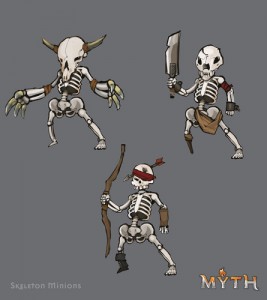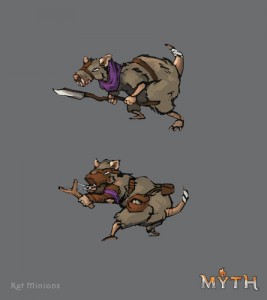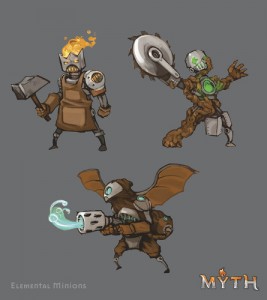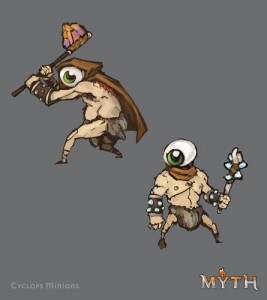I haven’t done a Q&A here at Lands of Myth in a while, but I am hoping to make up for it a little bit as we close in on the first boxes of MYTH shipping. Today, I’m very excited to have a question and answer session with Keith Lowe, who I had the pleasure of meeting at GenCon. Everyone who fell in love with the game is familiar with Keith and his artwork, but for those who don’t know Keith yet, he is the artist for MYTH, so you’ve seen his work, and will be seeing a lot more.
Lands Of Myth: Myth has obviously been a bigger success than you probably expected coming out of the gates. Has it had much impact on your life since the kickstarter ended?
Keith: Absolutely. I left my graphic design position at BradyGames of almost 8 years to pursue MERCS full time. It was a big decision, but an important one. There was such work to be done, that there simply wasn’t the time to try to continue doing both.
LoM: Concept art obviously played a big part in the game and the kickstarter. Could you tell us how the art process worked in the infancy of Myth before the kickstarter?
Keith: It was a bit of a mixed bag. Brian and Kenny had already some great ideas about the different classes as a jumping off point. We picked some traditional classes from that list to work on initially, but we also made a point to explore other ideas, like Brigand as a rat. Having creatures as heroes helped us be more open to try different things early on. For the baddies, we asked ourselves questions. “What are really great fantasy monsters? How can we give them a different flavor, make them unique but familiar?” When executing the monsters, I worked all of a monster group at that same time. So for example the Grubbers, Muckers, and Orcneas were all done together, to keep them cohesive as a group. The other thing I really wanted to push was story telling in the way the monsters looked. We do that in MERCS but I really wanted to make that a major focus with Myth.
LoM: We recently learned you were the artist for the first edition of Incursion. With a little research, I saw you also worked on Secrets of the Third Reich. Could you tell us a little bit about those projects?
Keith: Board Game Geek has me tagged as working on SOTR, but I never actually worked on it. I’m not really sure how it happened 🙂
As far as Incursion though, Jim Bailey reached out to me not long after we launched the MERCS website. This was sometime late in 2008. My job was primarily to illustrate the characters based off of concept art already finished, and in some cases miniatures in progress. I hadn’t done very much contract illustration work up to that point, so I felt like it was as a really good learning experience for me. I got to understand a little bit what it is like to be a freelancer. The art was fun to do, and Jim was an easy client to work with. We continued work off and on throughout the initial Incursion box release and into the SNAFU expansion as well. Eventually I had to discontinue, as MERCS was demanding more and more of my time.
LoM: Outside of MERCS, MYTH, and the two projects mentioned above, what other projects (even non-gaming) could fans of your art look up in order to find more of your artwork?
Keith: I spent a long time as a graphic designer for BradyGames and learned a ton there. I did designs for nearly a hundred books and strategy guides. I had a unique opportunity to work on game properties I loved when I was a young man. If you want, you can check out some of my old book designs on my insanely outdated website…
Beyond that, just little things here and there for friends and family. MERCS was a hobby for a long time, and I did the work during my free evenings. It just so happened that it was a business as well. I’m very fortunate in that my hobby has become my career.
LoM: Your art in both Myth and Mercs has a very distinctive style to it. Who were your biggest inspirations as you developed your style?
Keith: I appreciate that. I think every artist hopes their work feels somewhat unique. I’ve had a great many influences. Cartoonist Bill Watterson from Calvin and Hobbes when I was young. Comic artists like Jim Lee and in recent years penciler Cary Nord. The great American illustrators NC Wyeth, Howard Pyle, and JC Leyendecker. My college professor Ron Mazellan. Concept artists like Feng Zhu, Syd Meab, Sparth, Madryk, Craig Mullins. The list could go on…
LoM: What was your favorite piece of Myth art to design?
Keith: Wow that’s tough. I’ll have to say the Skeleton Boss, he felt unique and fun right from the get-go.
LoM: If you had to pick one miniature that’s been sculpted, which one do you think best caught the spark of the original concept art?
Keith: I about went nuts when I saw the Acolyte’s final sculpt images. He really captures the flavor to me.
LoM: Was there a reason you decided to go with sculpted miniatures over 3D graphic design? (This was a question a player had way back in May, that I’m circling back to.)
Keith: In terms of our business as a whole, we’ve had the most success with traditional models. From an artist standpoint, I also find it easier to see a models details, know they are at actual size, and can usually expect them to translate that way. Basically it becomes a what you see is what you get situation.
LoM: The box cover art is obviously the biggest, most in depth piece of art that’s been released for Myth. Are there other pieces you’ve done for the game that are that elaborate?
Keith: Right. The cover art was a priority early on to try to capture the look and feel in one big image. Nothing as elaborate as the cover has been illustrated yet, but I very much hope to do some more in the future.
LoM: How much unreleased (unleaked) art should we expect to see for the first time when we open up our game box?
Keith: If you weren’t able to catch us at GenCon, you will see loads of great new stuff. The Realm tiles look much sexier now than they did on the initial KS page. Fantastic item art from a super talented young artist Jonathan Duncan. He did an amazing job of on concepts and matched the style right on. Beyond this there is all the punchboard art, and last but not least, all the completed hero card art. We’ve posted bits and pieces of stuff on the KS updates from the core box, but the lions share we haven’t shown outside of GenCon.
LoM: 2014 (and probably 2015) is likely to have a number of expansions following the release of the game. How much new art do you expect to have to produce with each new expansion?
Keith: I’ll be in pretty solid shape for a while once I finish up the stretch goal work, which I’m actively working on now. Beyond that I’d love to do some more group illustrations with the expansion heroes.
LoM: Any final words for fans out there before the home stretch towards release?
Keith: I’m super pumped and I hope you are too! Thanks for taking this adventure with us 🙂
I’d like to thank Keith for taking time out of his busy schedule between continued work on MERCS, a hectic convention schedule, and getting MYTH finished to answer some questions for us. It means a lot.
For anyone interested in seeing more of Keith’s work, be sure to check out Keith Lowe Art.



























